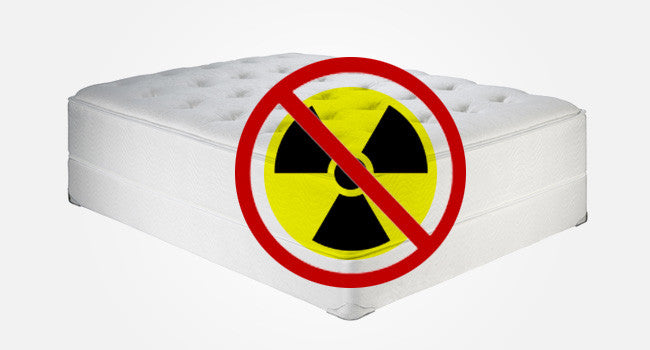Are you inhaling more than air as you sleep? A healthy mattress helps safeguard nighttime air quality. If you end your days on a conventional mattress, though, you may be sucking in chemical gases and insect waste that literally deprive you of oxygen. Less oxygen means less mental and physical renewal—and less-rewarding sleep.
Your body uses downtime to rejuvenate and perform crucial activities that rely, in part, upon oxidation. Breathing shoots needed oxygen to organ, muscle, bone, fat, and skin cells to rebuild energy and repair the days’ damage. How can a mattress wreck this performance? Toxic and allergenic compounds hidden in your sleep environment harm body mechanics, starting with your all-important breathing.
Your Respiratory System: The Movie, Playing Nightly
Oxygen circulation assists brain function, memory consolidation, and tissue growth while you rest. When you awake, your cognitive and motor skills are sharp, your organs work efficiently, and muscle, bone, and skin tissues are strong. You feel good, and you look fab, too.
Now, suppose some of the oxygen you need is replaced by other gases, or that your nose, throat, or lungs become irritated and less able to deliver the good stuff. Coil and memory-foam mattresses can cause these problems. Synthetics and flame retardants throw off invisible fumes that you ingest at the expense of O2 levels. As polyurethane memory foam breaks down, dust mites move into the interior spaces and leave droppings that eventually contaminate the air you breathe.
Impaired Sleep Contributes to Disease
You may become sensitized to insect poop or petrochemical compounds and experience respiratory distress or tissue irritation. Congestion and itching jolt you from sleep, preventing your body from completing its nightly DIY projects. A 2014 medical study published in Clinics of Chest Medicine correlates indoor air pollution and respiratory disruption, suggesting that impaired sleep contributes to disease. The wrong mattress can, indeed, suffocate a good night’s sleep and create chronic health problems.
Without Healthy Breathing, There May Be No Sequel
So, your bedroom looks clean and has good air circulation. Why worry? If you lie on a synthetic mattress, you’ll absorb contaminants through your skin or inhale them through your nose and mouth. Labs have isolated more than 60 dangerous chemicals present in conventional mattress padding and adhesives—including formaldehyde, acetone, naphthalene, benzene, and many more volatile organic compounds (VOCs).
Allergic rhinitis is a common effect of prolonged respiratory distress provoked by chemical ingestion. The resulting inflammation and obstruction of airways increase the chances of developing asthma and sleep apnea. These two conditions are irreversible and require lifelong medical management. Without drugs or medical devices to alleviate symptoms, reports the University of Maryland Medical Center, more serious problems can arise.
People with untreated asthma can actually die from suffocation during severe “attacks” that prevent oxygen from reaching the brain and other organs. Uncontrolled sleep apnea, a disorder in which the airways collapse during sleep, promotes high blood pressure, heart disease, and—not surprisingly—chronic insomnia.
The Wrong Mattress Can Make Anyone Sick
Children, elders, and people with compromised health are the most vulnerable. But the wrong mattress can make anyone sick. With one-third of your life spent in bed, over time, respiratory problems brought on by an unhealthy mattress can raise your risk for:
- Sinusitis
- Ear infections
- Obesity
- Type 2 diabetes
- Stroke
- Heart attack
- Heart failure
And that list doesn’t include other complications linked to mattress plastics and flame retardants, such as neurological disorders, hormonal disruption, and cancer. But, don’t make out your will yet! You have the power to prevent these illnesses by renovating your sleep environment, starting with what’s right under your nose: your mattress and pillows.
Best-Supporting Actor: A Nontoxic Mattress
Technological advancement has been a double-edged sword for sleep. Thick, durable mattresses were made possible with synthetic glues and padding formulations, while chemicals that keep beds from catching fire made sleep “safer.” What developers didn’t know was how these compounds affect people over time.
As it turns out, we may have enjoyed healthier sleep before this so-called progress. Trends toward natural and organic foods, fabrics, and household products brought a return to what did work: supportive mattresses and pillows made from all-natural, renewable resources. New manufacturing techniques improve on tried-and-true materials to produce today’s organic mattress—your best bet for a healthy night’s sleep.
Natural latex made from “green” rubber trees provides the cush we’re used to and leaves no room for dust mites to invade. Wool from organically raised sheep lends loft and intrinsic flame protection. Cotton untreated with pesticides and other chemicals wraps it all in a comfy layer of cloth that’s good for your skin. But what about your respiratory system?
Today’s Organic Mattress—Your Best Bet for a Healthy Night’s Sleep
In that regard, it’s all good. The American Lung Association recommends controlling indoor air pollution by avoiding products that contain VOCs and by reducing exposure to dust mites. A healthy mattress made with certified organic materials contains no harmful adhesives or chemical treatments and naturally wards off dust mites. Best of all, you won’t sacrifice comfort or durability. You can look forward to sleeping on a supportive organic mattress for an average of twenty restful years.
